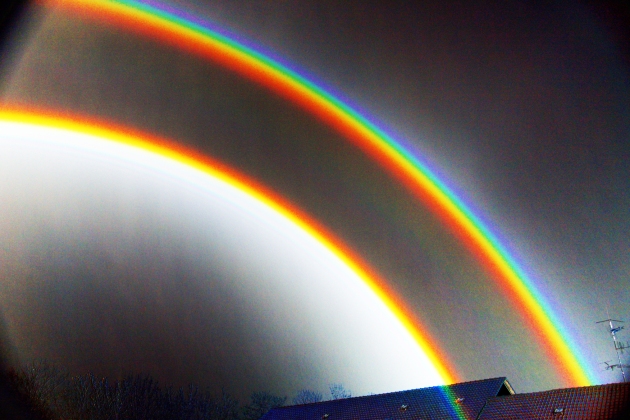Three possible photographic detections of the natural fifth order rainbow from Germany
In 2014, Harald Edens reported ten cases of photographically detected natural quinary rainbows, recorded during 2009-2013 in New Mexico, USA, at altitudes of 1.8-3.2 km. These and some newer observations can also be found on his website.
So far, no reports from other locations have been published. In the German observers’ network, we analyzed many candidate photographs showing bright primary and secondary rainbows, but from most of them no reliable traces of quinary rainbows could be extracted. Such analyses are not easy, as the quinary signal is weak compared to the neighboring secondary rainbow, and processing methods such as unsharp masking can cause a leakage of colors into Alexander’s dark band. Furthermore, the processing operator will experience disturbing afterimage issues from the intense renditions of the primary and secondary on the screen after a couple of minutes.
Despite these difficulties, we now believe that we have identified three cases of genuine quinary rainbows. In cases 1 and 3, the quinary could be extracted from several photographs. Nonetheless, in order to keep this blogpost brief, we restricted ourselves to show only one image (or the results from one polarization series in case 1) per observation. We chose a straightforward processing method (= only increasing contrast and saturation, no local filtering such as unsharp masks) similar to the one applied by Harald Edens to allow for an easier comparison with his results. Alternative processing routes will be presented at a later stage.
1) April 22nd, 2012, near Göttingen, Germany (51° 31’ N, 9° 58’ E, altitude 250 m), 19:16 CEST, sun elevation 10.2°, photographed by Frank Killich after a moderate shower
The original intention of Frank Killich was to use the primary and secondary rainbows as test objects for a home-built photopolarimetric setup made from a Canon 20D camera and a linear polarizer precisely rotatable by a stepper motor. By recording four successive images at polarizer positions of 0°, 45°, 90° and 135° with respect to the vertical, it is possible to reconstruct the first three components of the Stokes vector for each viewing direction (pixel coordinates) and color channel (red, green, blue) individually. These images can be numerically combined to reconstruct the unpolarized intensity (= the ordinary photographic result without a polarizer) and, moreover, the linearly polarized portion of the recorded light distribution (= the total intensity with the unpolarized background removed for each pixel). In the case of rainbows, this corresponds effectively to a subtraction of the radial (weak) component from the azimuthal (strong) polarization component equally all along the visible part of the circumference. As known from theory, also the quinary will be easier to detect in such a polarization contrast image.
Unpolarized intensity as calculated from the original images, f = 22 mm:
Unpolarized intensity, increased saturation and contrast:
Linearly polarized portion as calculated from the original images:
Linearly polarized portion, increased saturation and contrast:
The expected broad bands of green and blue are clearly visible in the processed linearly polarized portion picture, and might be slightly visible also in the unpolarized intensity.
The other two photographic observations were carried out without any polarizers, i.e. only the unpolarized intensity information is available in these cases.
2) March 20th, 2013, near Pforzheim, Germany (48° 56’ N, 8° 36’ E, altitude 312 m), 16:21 CET, sun elevation 21.1°, photographed by Michael Großmann after an intense shower
Original (Canon EOS 450D, f = 22 mm):
Increased saturation and contrast:
A slight green/blue hue is visible inside the secondary at and slightly above the horizon.
3) May 15th, 2016, Mt. Zschirnstein, Germany (50° 51’ N, 14° 11’ E, altitude 560 m), 19:57 CEST, sun elevation 6.2°, photographed by Alexander Haußmann after a moderate shower
A description of this observation (without discussing the quinary rainbow) can be found here. The images shown here are cropped from a fisheye photograph.
Original (Pentax K-5, f= 17 mm, cropped):
Increased saturation and contrast:
Again, a slight green/blue hue appears close to the horizon.
At this point it is of course not possible to draw any statistical conclusions about the frequency of detectable quinary rainbows. However, it seems worthwile that every rainbow observer re-examines his photographical treasure trove for previously overlooked rarities, even if no polarizer enhancement was involved during photographing.
Posted on August 16, 2016, in observations, rainbow and fogbow and tagged fifth order rainbow, high order bows, rainbow. Bookmark the permalink. Leave a comment.








Leave a comment
Comments 0